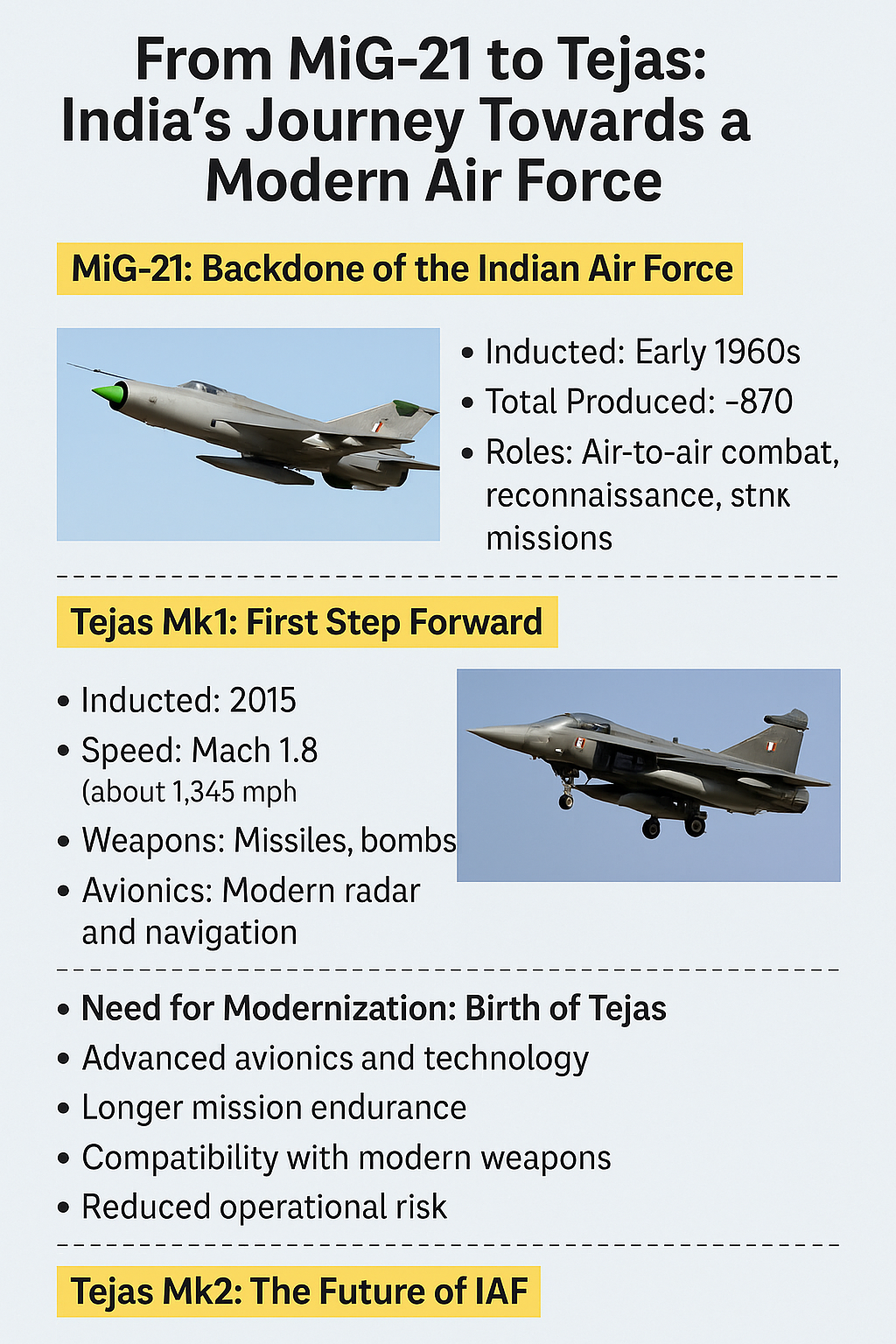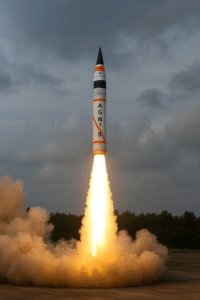After more than six decades of service, India’s MiG-21 fighter jet is finally being retired. For anyone interested in Indian defence, the Air Force, or military technology, this retirement marks the end of an era. The MiG-21, often called the backbone of the Indian Air Force (IAF), has served the nation with unmatched dedication, and its legacy will be remembered for generations.
Over the years, the MiG-21 was pushed far beyond its designed capacity. Experts consistently warned that flying the aircraft was increasingly risky. Yet, its remarkable performance in crucial operations cannot be overlooked. The Balakot airstrike in 2019 stands as a testament to its enduring capabilities, where old-generation MiG-21s successfully engaged modern F-16 jets.
Like all machines — and indeed, like all things in life — every aircraft has its journey. Once its purpose is fulfilled, it naturally retires. The MiG-21’s journey, spanning over six decades, was a perfect example of reliability, endurance, and commitment.
MiG-21: The Backbone of the Indian Air Force
The MiG-21 was inducted into the Indian Air Force in the early 1960s and quickly became the workhorse of the fleet. Over its service life, India produced nearly 870 MiG-21s in multiple variants. These aircraft were involved in nearly every major operation and conflict, from the Indo-Pak wars to recent skirmishes.
Key Features & Legacy:
- Speed and agility: Capable of supersonic flight, essential for interception missions.
- Versatility: Adaptable for air-to-air combat, reconnaissance, and strike missions.
- Global recognition: One of the most widely used fighter jets in the world.
Despite being labeled the “Flying Coffin” due to its increasing risk with age, the MiG-21 proved its mettle repeatedly. Its design limitations were pushed to the extreme, yet it delivered reliable performance, earning respect from both pilots and defence experts alike.
The Need for Modernization: Birth of the Tejas Programme
By 1983, the IAF realized that the demands of modern air combat required a lighter, more technologically advanced fighter jet. While the MiG-21 had served admirably, the changing nature of aerial warfare demanded:
- Enhanced avionics and navigation systems
- Increased endurance for longer missions
- Compatibility with modern weapons
- Reduced maintenance and operational risks
These requirements gave birth to India’s indigenous Tejas fighter jet programme, a project designed to reduce dependency on imported aircraft while introducing next-generation technology to the IAF.
Tejas Mk1: The First Step Forward
The Tejas Mk1 was developed as the first operational version of India’s Light Combat Aircraft (LCA). Its design focused on lightweight construction, fly-by-wire control systems, and versatile combat capabilities.
Key specifications of Tejas Mk1:
- Maximum speed: Mach 1.8 (nearly twice the speed of sound)
- Weapons capacity: Air-to-air and air-to-ground missiles, bombs
- Avionics: Modern radar and navigation systems for day/night operations
Though a promising aircraft, Tejas Mk1 was a stepping stone. Operational requirements led to the development of Tejas Mk1A, which incorporates enhanced avionics, improved weapons integration, and more robust performance.
Tejas Mk1A: Bridging the Gap
The IAF has ordered 180 Tejas Mk1A aircraft, expected to enter service from 2026. These jets will primarily serve defensive missions within Indian airspace.
Challenges faced during development:
- Engine supply delays from GE
- Integration of specialized weapons and electronic warfare systems
- Rigorous testing for reliability and operational readiness
The Mk1A represents a compromise between early operational needs and technological advancement, ensuring that the IAF can gradually retire MiG-21s without compromising defence capabilities.
Tejas Mk2: A Leap into the Future
While the Mk1A addresses immediate requirements, the Tejas Mk2 is designed for long-term strategic roles. This version is larger, more powerful, and intended to match the capabilities of the Mirage 2000.
Improvements in Tejas Mk2:
- Higher endurance for extended missions
- Increased firepower, including integration with Astra Mk2 missiles
- Advanced radars and sensors for precise targeting
- Optimized for both offensive and defensive missions
Initially expected to fly in 2022, the Tejas Mk2’s first flight has been rescheduled to 2027 due to technical and integration challenges. Despite delays, the IAF emphasizes that only fully operational jets will be inducted, avoiding the pitfalls experienced with the MiG-21.
Modernizing the Indian Air Force
The retirement of the MiG-21 has reduced India’s fighter squadron strength to a six-decade low. On paper, the IAF maintains 31 squadrons, but in operational terms, the number stands at 29. This shortage highlights the urgency of modernizing the fleet.
Future Fleet Composition:
- Upgraded Su-30 MKIs for multi-role missions
- Rafale jets manufactured in India
- Tejas Mk1A and Mk2 for defensive and offensive roles
- Advanced Medium Combat Aircraft (AMCA) for stealth and advanced missions
- Potential 5th-generation fighters through imports or “Make in India” initiatives
By 2030, older jets like MiG-29, Jaguar, and Mirage are expected to be phased out, paving the way for a modern, diversified, and technologically advanced fleet.
The Strategic Importance of Tejas Mk2
The Tejas Mk2 will play a key offensive role in India’s aerial strategy. Its integration with modern weapons, radars, and sensors ensures that the IAF has a capable aircraft for high-intensity combat scenarios. Unlike a uniform fleet, each type of fighter is tasked with a specific role:
- Tejas Mk2: Offensive missions, precision strikes
- Tejas Mk1/Mk1A: Defensive patrols, airspace security
- Rafale and Su-30 MKI: Multi-role strategic operations
This diversified approach ensures the IAF can meet a wide range of defence requirements without over-relying on a single aircraft.
Lessons from the MiG-21
The MiG-21’s long service teaches several lessons for the IAF:
- Operational longevity vs. replacement readiness: Flying old aircraft beyond their intended lifespan carries risks.
- Indigenous development matters: Reliance on imports may cause delays; homegrown programs like Tejas are crucial.
- Balancing legacy with modern needs: The IAF can honor past achievements while preparing for future challenges.
Conclusion: Balancing Legacy with Innovation
The retirement of the MiG-21 marks the end of an iconic era in Indian defence history. Its legacy of reliability, bravery, and adaptability will never be forgotten. At the same time, the Tejas programme, with Mk1A and Mk2, represents India’s ambition to create a self-reliant, technologically advanced air force.
From the MiG-21 to Tejas Mk2 and beyond, India’s journey reflects a careful balance between honoring legacy and embracing innovation. With a modernized fleet, the IAF is poised to meet the challenges of the 21st century, ensuring that India remains secure and prepared for the future.



